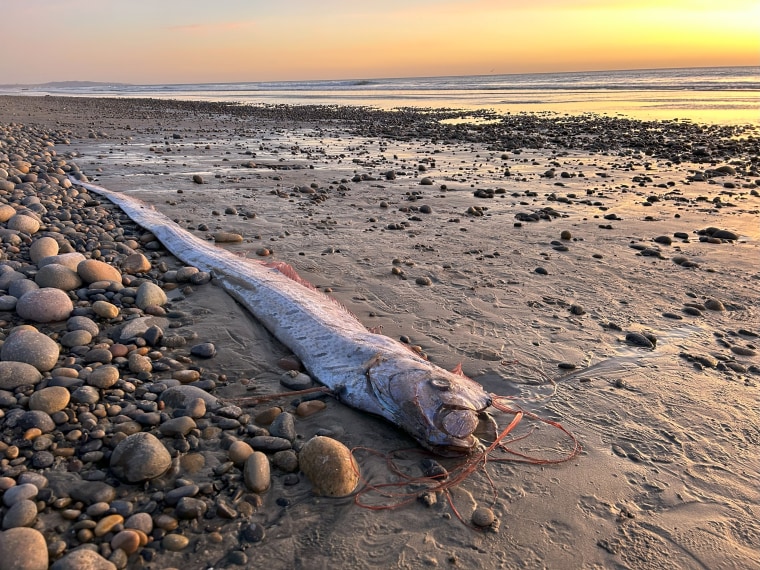
The
legendary “doom fish”
has returned to
California.
A long, ribbon-shaped oarfish, rarely seen and believed to signal disaster, has washed up on California’s shores for the second time this year.
PhD candidate Alison Laferriere from the Scripps Institution of Oceanography at UC San Diego discovered the nearly 10-foot-long oarfish on a beach in Encinitas, in
southern
California
, last week.
Oarfish are elusive creatures
that dwell in
the deep ocean
— often as far as 3,300 feet below the surface — in the mesopelagic zone, a dark region beyond the reach of sunlight.
These mysterious fish, which can grow up to 20 feet long, remain largely unstudied by scientists, according to the National Oceanic and Atmospheric Administration.
Rare, monstrously-proportioned and strangely-shaped, oarfish have sparked myths and legends for centuries and are sometimes referred to as the “doomsday fish” due to their reputation as predictors of
natural disasters or earthquakes.
In 2011, the largely forgotten “earthquake fish” legend resurfaced after 20 oarfish washed ashore in the months leading up to Japan’s most powerful recorded earthquake.
The devastating tsunami that
struck
the c
o
untry o
n March 11, 2011, killed more than 15,000 people
and was triggered by a
9.0-magnitude earthquake
that gave the sea floor a massive shove toward Honshu, Japan’s largest island.
According to the Scripps Institution, oarfish are incredibly rare.
Since 1901, only 21 oarfish have been documented washing up on California shores.
Ben Frable, a researcher at the Scripps Institution, suggested that
shifts in ocean conditions
, along with a potential increase in oarfish populations, may be behind the uptick in sightings, he said in a statement this August, after the first oarfish was found.
That oarfish, which measured 12 feet long, was spotted by kayakers and snorkelers in La Jolla Cove, north of downtown San Diego. The fish was then transported to the NOAA’s Fisheries Science Center in La Jolla for further study.
“Rare encounters like this offer an incredible opportunity to learn more about this species and its behavior,” Frable said.
Frable also noted that while scientists are unsure of the exact causes, La Jolla’s shores, which is near two underwater canyons that funnel deep water up to shore, tends to be a hotspot for disoriented or injured deep-sea fish to wash up.
As scientists continue to study these rare appearances, the mysterious oarfish is sparking curiosity and intrigue.
A 2019 study by researchers in
Japan
, found no solid scientific evidence linking oarfish to earthquakes — leaving the doom they may or may not portend open to anyone’s guess.
Note: Thank you for visiting our website! We strive to keep you informed with the latest updates based on expected timelines, although please note that we are not affiliated with any official bodies. Our team is committed to ensuring accuracy and transparency in our reporting, verifying all information before publication. We aim to bring you reliable news, and if you have any questions or concerns about our content, feel free to reach out to us via email. We appreciate your trust and support!
